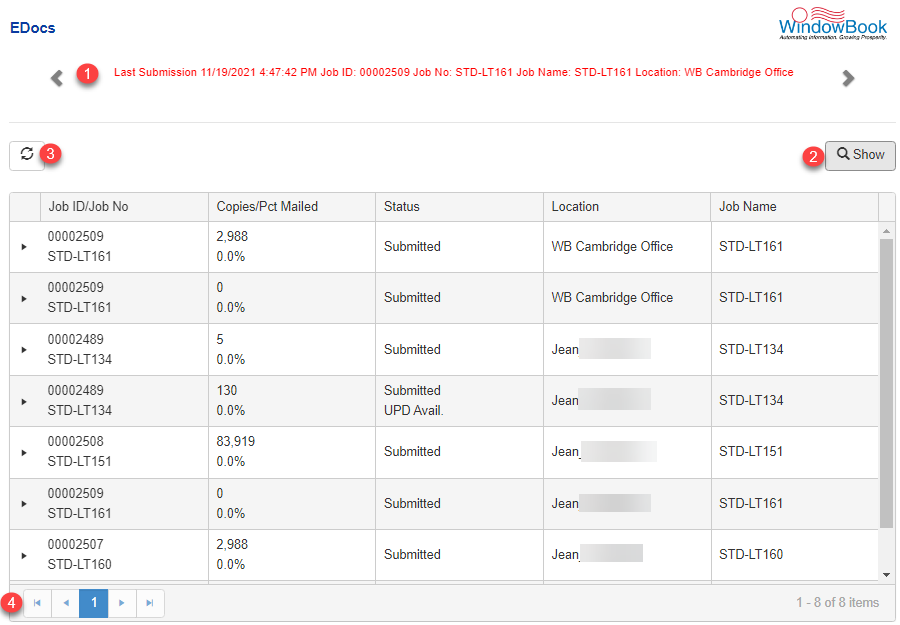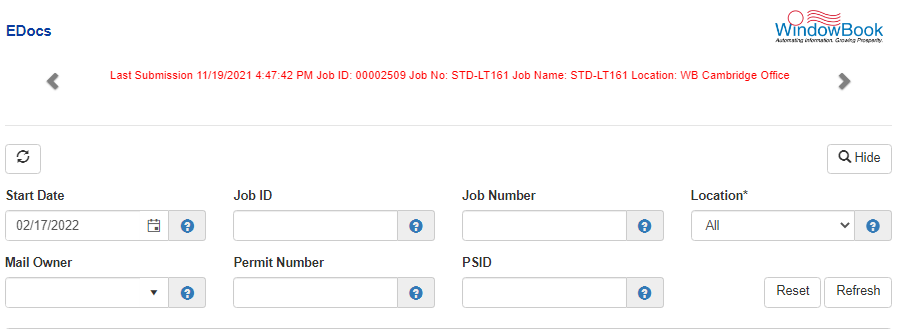EDocs Menu > Edocs Dashboard
Role Access: ALL (except the Services and Manual Statement options)
Clicking on Edocs Dashboard will bring you to the list of jobs that have been submitted to PostalOne!.

The Dashboard screen is displayed immediately after clicking the EDocs Dashboard option. The Dashboard screen displays the list of jobs submitted to, and returned from, PostalOne!. Above the list of jobs, ![]() a message, either red or green, alternates every 30 seconds between the latest submission to PostalOne! and the latest receipt from PostalOne!.
a message, either red or green, alternates every 30 seconds between the latest submission to PostalOne! and the latest receipt from PostalOne!.
The jobs are displayed in order of PostalOne! processing time, with the most recently processed job, displayed first in the list.

Search Filters
![]() Show: Open the Search Filters section.
Show: Open the Search Filters section.
An explanation of each option or field is shown below the print screen:

Fields
Start Date: The date shown is the last date of the jobs to be displayed (inclusive). Only jobs with dates previous to the date shown will be displayed. Jobs with dates after the date displayed will not be shown. This filter is not used if the Job ID, Job Number, or PSID is used as a filter.
The Start Date value is limited to the previous 90 days.
Job ID: Filters on a Job ID. Entering the entire Job ID string is not necessary; it is only necessary to enter as many leading characters as needed to filter the list as desired. Multiple jobs may be displayed if the whole Job ID is not entered. The Start Date is not used as a filter when this field is used.
Any leading zeros must also be entered.
Job Number: Filters on a Job Number. Entering the entire Job Number is not necessary; it is only necessary to enter as many leading characters as needed to filter the list as desired. Multiple jobs may be displayed if the whole Job Number is not entered. The Start Date is not used as a filter when this field is used.
Location: Used to filter by a single location if desired. This filter is required and is always used in combination with the other filters. The ability to select one or multiple locations is predicated on the ‘role’ assigned to the user currently logged in.
Mail Owner: Used to filter by a specific mail owner. This drop-down list is automatically populated as the PostalWeb service processes statements.
Permit Number: Used to filter displayed jobs by the permit number used.
PSID: Used to filter displayed jobs by the PostalOne! Statement ID.
In addition, there are three control or function buttons used with the available filters:
Reset: The filter settings will be reset to their default settings when clicked.
Refresh: Used to update the displayed jobs list whenever a filter is changed. The button will turn blue when the displayed data is stale, and the Refresh button needs to be clicked.
Hide: When clicked, the filter settings will become hidden, at which time the label on the button will change to display as Show.
Job Information

Job ID/Job No: Shows the Job ID and Job No. associated with the Mail.dat file.
Copies/Pct Mailed: ‘Copies’ are the total piece count / the percent mailed. The percent mailed is based on the number of pieces in ‘ready to pay containers’ successfully submitted to PostalOne! but are not necessarily finalized.
Status: The status of the job as a whole. Since a single job may consist of multiple Mail.dat files, the Mail.dat files may be in different states as processing continues. Therefore, this is a rough status indicator. The possible status values are:
-
Submitted
-
Partially Finalized
-
Finalized
Location: One of the locations previously defined in the Manage Locations screen.
Job Name: The job is a free-form description referred to as the Job Name/Title & Issue field in the Mail.dat HDR file.
The details of each job in the list can be viewed by clicking the  Expand arrow.
Expand arrow.

Click on the release filename, and additional details will display.

There are seven release files associated with the job in the example above.
MD File: The name of the release file uploaded via the MDR Client.
Paid/Spld (Spoiled): The number of pieces paid for / the number of spoiled pieces.
Date: The date of the last event.
Message: The activity that happened at the last event.
For each event as the Mail.dat is processed, the following is shown:
Event: The name of the event that took place. The possible events are:
-
Accepted
-
Validated
-
Generated
-
Finalized
Pieces: The number of pieces involved in the event.
Postage: The total amount of postage for the event.
Date: The date and time of the event.
Return to EDocs Menu